'Mud Monsters' Galore! Mariana Trench Dive Yields Bizarre Deep-Sea Life

A recent underwater expedition to the Mariana Trench, the deepest known ocean spot in the world, filmed many forms of bizarre marine life close to the seafloor, and captured the first-ever footage of a shrimp feeding at record-breaking depths.
Sponges on stalks, ghost-pale lizard fish and a hermit crab carrying an anemone hitchhiker were among the so-called "mud monsters" that paraded in front of the cameras of the remotely operated vehicle (ROV), offering a rare glimpse of deep-sea animals' habits and lifestyles that are normally extremely challenging to observe and study.
High-definition video even allowed researchers to identify the tiny filter-feeding shrimp on a species level; they determined that it closely resembled Bathystylodactylus bathyalis, a species that was previously known only from a single broken specimen. This is the deepest ocean observation of this group of shrimp to date, the scientists wrote in a new study. [Deep Ocean 'Mud Monsters' Captured By ROV | Video]
The shrimp and its deep-sea comrades were spotted by the Deep Discoverer (D2), an ROV deployed by the Okeanos Explorer vessel, during an expedition conducted by the National Oceanic and Atmospheric Administration (NOAA) between April 20 and July 10, 2016. The expedition explored areas in and around the Mariana Trench Marine National Monument (MTMNM) and the Commonwealth of the Northern Mariana Islands (CNMI), according to NOAA.
On June 30, 2016, D2 dove to 15,833 feet (4,826 meters) below the surface to investigate a site — possibly a mud volcano — called Twin Peaks, where the seafloor was thickly coated with sediment, NOAA officials said in a statement.
D2 cameras spied the shrimp about 2 hours and 17 minutes into the dive. It was an unusual sighting for this depth, so the observing scientists directed the ROV to take a closer look and capture detailed images.
The shrimp measured about 4.7 inches (12 centimeters) long and was facing into the current with its front legs held high, "presumably using its legs as a net to capture passing particles," the study authors wrote. In a closer shot of the shrimp's head and appendages, video revealed tiny hairs fringing its limbs.
Sign up for the Live Science daily newsletter now
Get the world’s most fascinating discoveries delivered straight to your inbox.
Prior to this sighting, scientists were uncertain about how the shrimp might have used its appendages, because the only known specimen's condition was poor. This video provides important clues about how the shrimp captures its food in the ocean depths, the scientists explained in the study.
Many of the peculiar creatures D2 spied on the ocean floor during its 5-hour dive prompted astonished reactions from scientists who were observing remotely, some of which are audible on the video D2 captured. The sight of a blobby acorn worm — a limbless marine worm with an acorn-shaped head — in delicate shades of purple and pink prompted a researcher to exclaim, "That is the craziest-looking thing!"
Another voice on the video declared, "This is a weird one; this is very cool," about an isopod — a type of crustacean — with a number of long, spindly legs.
Meanwhile, a gracefully undulating sea cucumber, with the top of its flexible body curving over to resemble a parasol, prompted cries of, "Oh, this is fantastic!" and a comparison to the fictional British nanny Mary Poppins, who was carried aloft by her umbrella.
The findings were published online Jan. 24 in the journal ZooKeys.
Original article on Live Science.

Mindy Weisberger is an editor at Scholastic and a former Live Science channel editor and senior writer. She has reported on general science, covering climate change, paleontology, biology and space. Mindy studied film at Columbia University; prior to Live Science she produced, wrote and directed media for the American Museum of Natural History in New York City. Her videos about dinosaurs, astrophysics, biodiversity and evolution appear in museums and science centers worldwide, earning awards such as the CINE Golden Eagle and the Communicator Award of Excellence. Her writing has also appeared in Scientific American, The Washington Post and How It Works Magazine. Her book "Rise of the Zombie Bugs: The Surprising Science of Parasitic Mind Control" will be published in spring 2025 by Johns Hopkins University Press.









